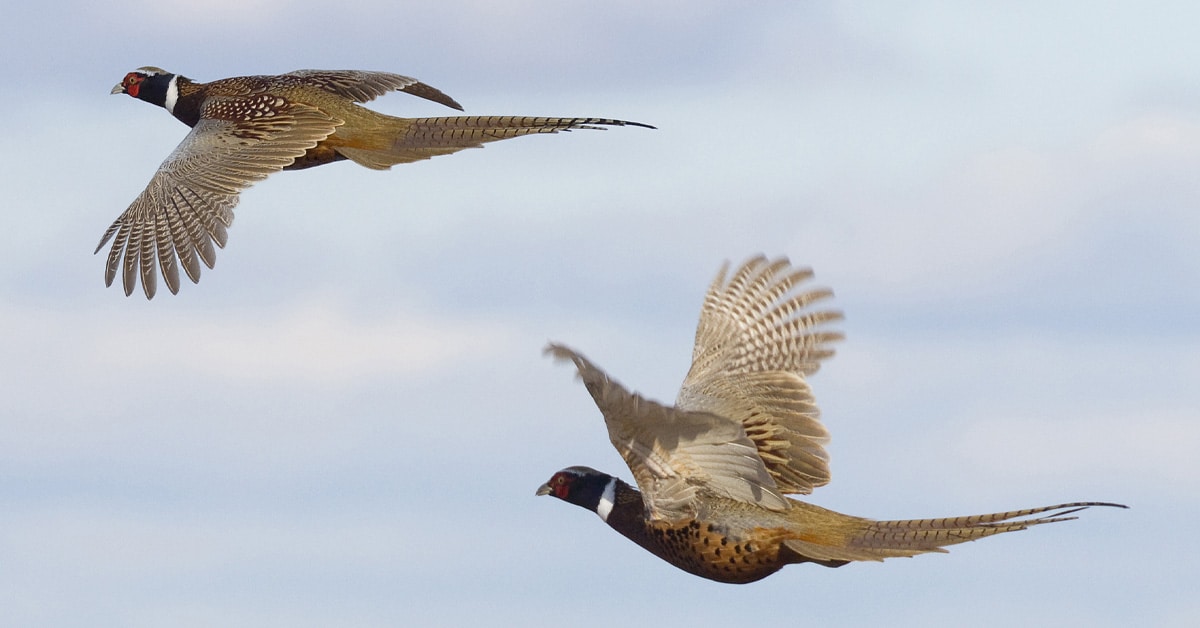The industrial scale of rearing pheasants for the shooting industry has been uncovered by Who Owns England’s Guy Shrubsole in a series of FOI requests on the poultry registry made to APHA (the Animal and Plant Health Agency).
Every year the shooting industry releases around 40 million Common Pheasants and 10 million Red-legged Partridges for its clients to kill. Writing on his site, Shrubsole says that his FIOs revealed just “131 shoots and game farms are responsible for rearing and releasing a staggering 6.2 million pheasants in England. At most 43 premises rear 4.7m pheasants; a maximum of 88 premises release 1.5m pheasants“.
Furthermore, he asked APHA for the data to be broken down into the three categories recorded when pheasants are registered: 1) breeding for shooting (ie. to produce new birds), 2) rearing for shooting (ie. the raising of chicks until they are ready to be released), or 3) releasing for shooting (ie. pheasants released into pens in woods and fields, ahead of the shooting season starting).
According to APHA the stats are as follows:
Breeding for shooting – 1.2 million pheasants
Rearing for shooting – 14.7 million pheasants
Releasing for shooting – 9.8 million pheasants
The difference between the full total of pheasants released to be shot – 40 million – and the smaller figures above is explained by two factors: most pheasants are still being bred in France and other countries outside the UK and imported; the shooting industry doesn’t bother keeping records – as Shrubsole points out “Natural England has complained about “the lack of compliance with the poultry register” by pheasant shoots”.

Where on earth are all these birds?
Shrubsole is an absolute master of breaking data down. He took postcode information provided by APHA of where pheasants were being kept (typically so-called ‘game farms’ like the vast Bettws Hall Farm in Wales hit by an Avian Flu outbreak in May 2023) to plot where the highest densities of birds were registered.
For a full set of maps please see ‘Who Owns England‘, but Shrubsole discovered that “SY5, in Shropshire, accounts for the rearing of over a million pheasants by itself – and in ‘less than 5’ premises: suggesting some very large game farms in this part of the country“. Centred on Shrewsbury, SY5 also covers part of the Shrewsbury Hills AONB, which surprisingly doesn’t mention shooting at all on its website although a plethora of shoots operate here including The Gatten, Leigh Hall Estate, and Sibden Castle. Most offer ‘flexible bag sizes from 200 – 500’, meaning groups of around nine shooters will each kill at least fifty pheasants on their day out.
As anyone following the shooting industry might have predicted, vast numbers of pheasants were also concentrated around National Parks (to quote Shrubsole “Postcode districts bordering the North York Moors and on the edge of Exmoor also feature“). Much of the UK’s ‘national parks’ aren’t the wildlife havens many people believe them to be, but are in fact managed for shooting: the North York Moors NP authority for example owns just 1% of the park, with 80% in private ownership. As we have stated many times, North Yorkshire is notorious as a ‘black hole’ for birds of prey and has become synonymous with the illegal persecution of raptors.

The shooting industry
It’s not so long ago that campaigners using the term ‘shooting industry’ were derided in the media. Lobbyists from the likes of the Countryside Alliance claimed that shooting was ‘sport’ and was all about a few men and women enjoying a walk in the countryside together, occasionally flushing a pheasant or two and heading home again.
The truth, as Who Owns England proves again, is entirely different.
- This morally indefensible industry has grown massively in the last few decades (estimates are that there has been a 900% increase in the number of pheasants released since the 1960s).
- It intensively rears millions of ‘live targets’ in often appalling conditions (see our investigation with the Hunt Investigation Team into Lancashire’s Leighton Hall shooting estate).
- It floods an already depleted countryside with millions of non-native birds (neither pheasants nor Red-legged Partridges are native to the British Isles and are only here because a small number of people want to shoot them).
- It is an industry that is responsible for raptor persecution (the illegal killing of birds of prey like Buzzards, Goshawks, and Hen Harriers, see Birds of prey and the Law), the blocking and removal of badger setts (illegal under the Protection of Badgers Act), and the snaring and trapping of vast numbers of foxes and other native predators (no one knows exactly how many because there is no requirement in England and Wales to keep data but over a million animals year is probably an underestimation).
- And while millions of pheasants will die on roads every year, and an untold number will be scavenged by the very mammals and birds the industry relentlessly persecutes in a supposed effort to ‘restore balance’ (an absolutely laughable proposition given the releases of so many non-native birds in the first place).
The bird shooting industry is a disgrace and has no place in this or any other century. Protect the Wild is determined to end it. It won’t be easy, but the same was said when the feather industry was challenged more than a century ago, when a ban on whaling was proposed in the 1960s, and when hunt sabs and empathetic politicians drove forward the Hunting Act and a ban on hunting wild mammals with dogs.

